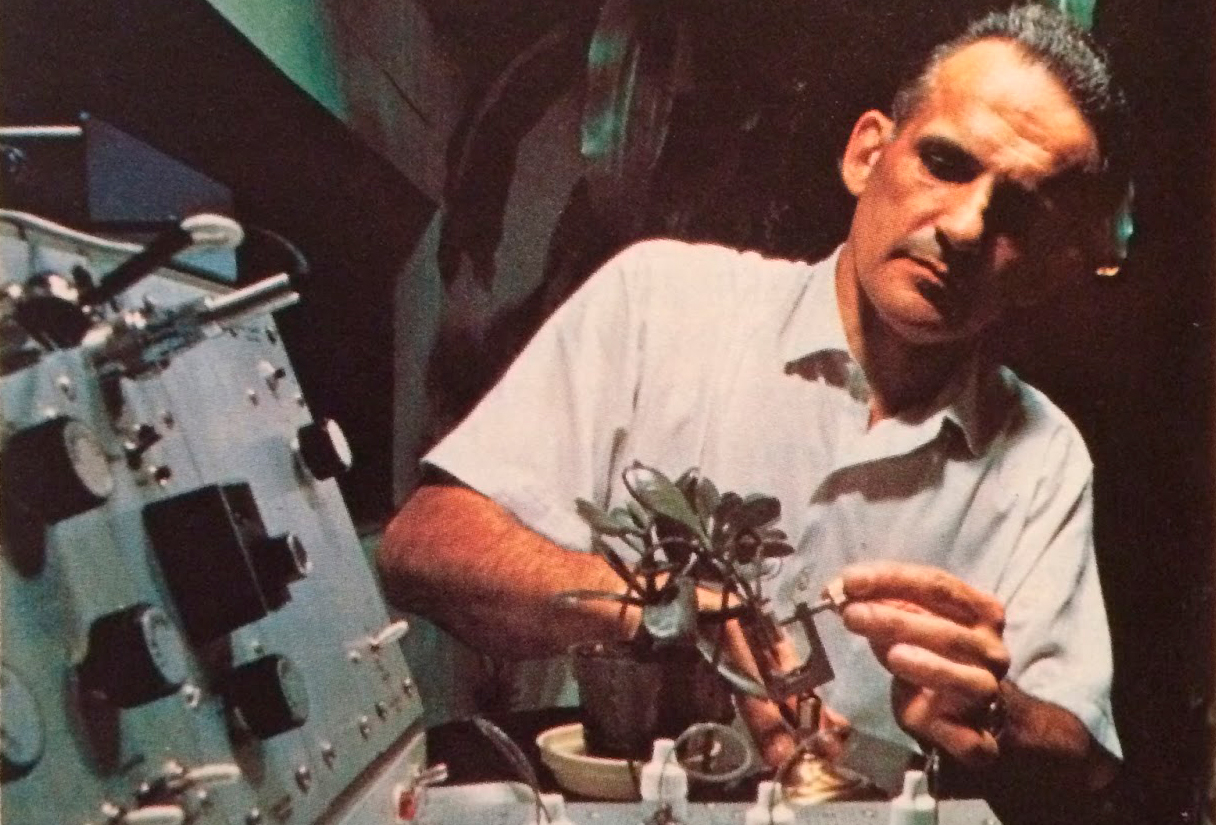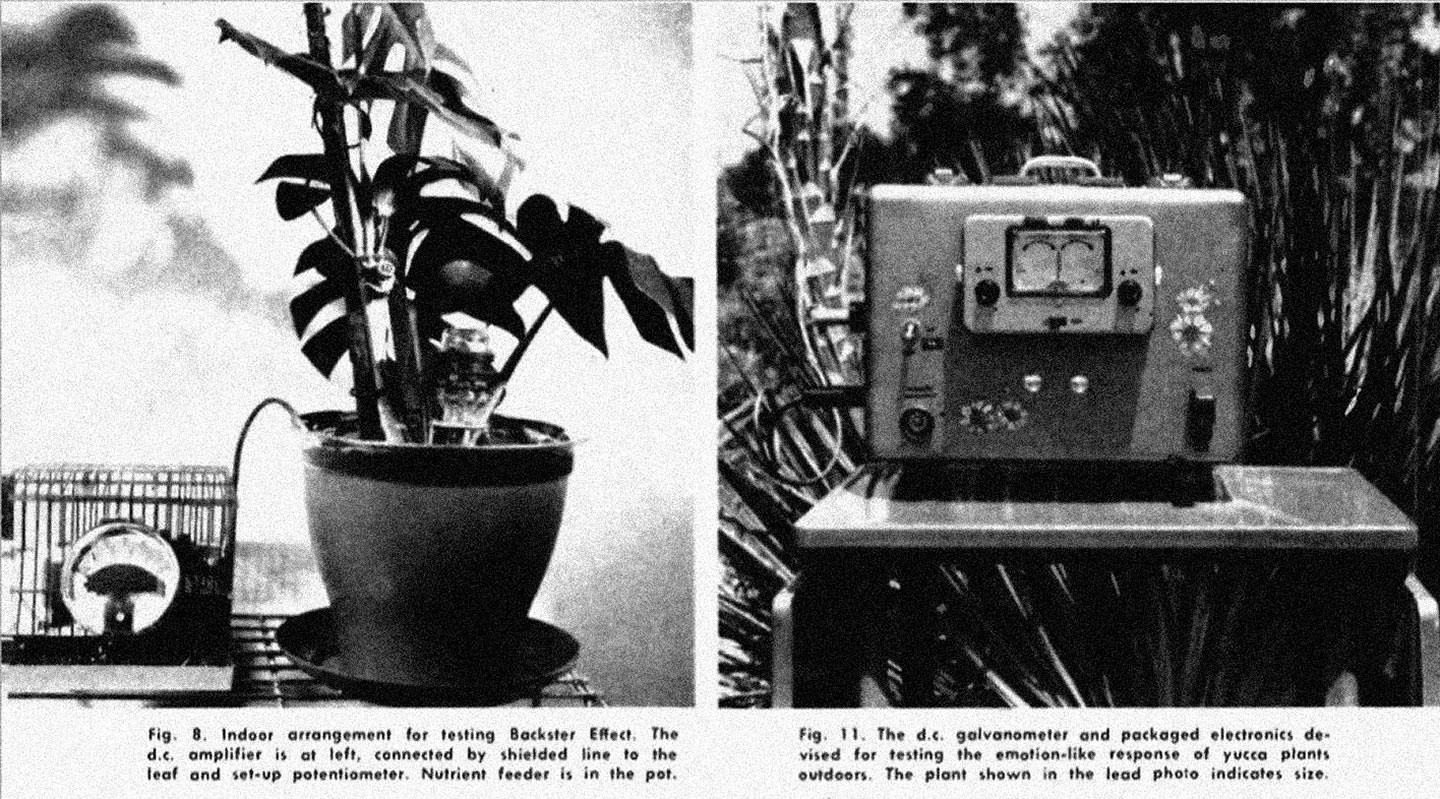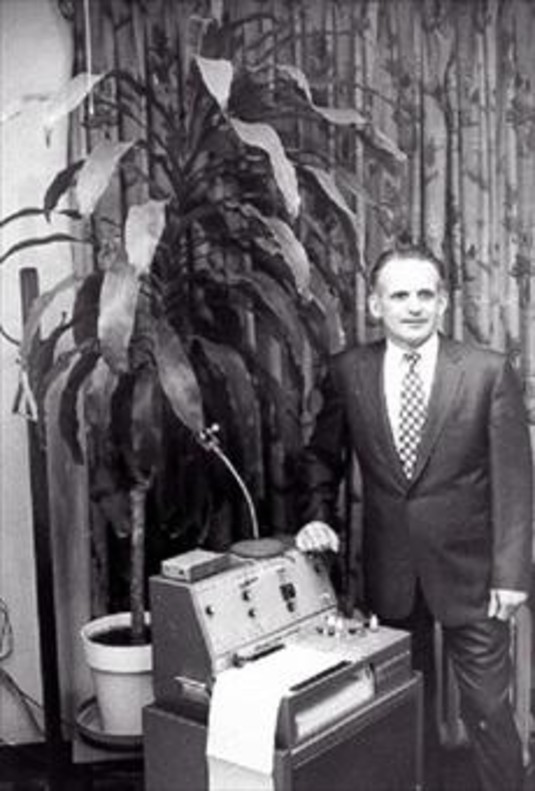Exo-Science.com
The Story of Cleve Backster
If you don't know who that is, this story will completely change the way you view the world. I'm not even exaggerating, you'll never be the same again after this.

In the 1940s Cleve Backster served in the Counter-Intelligence Corps, where he once hypnotised a secretary to leak documents to him, just to prove a point. In 1948 he joined the CIA, where he was a pioneer of polygraph technology, where he was involved in interrogations with sodium pentothal (truth serum) and God knows what else.
He devised what became the worldwide standard for lie detection: Backster Zone Comparison Test.
He left the CIA to start his own polygraph business, which went well until everything changed on February 2, 1966.
His secretary bought a plant, a Dracaena, it was the first plant he ever owned.

He connected it to a polygraph and to his surprise, it was jittery and alive, changing over time.
After a minute, it showed a significant, short spike. If a man had this reaction, he'd be distressed.
He tried dipping a leaf in hot coffee, but nothing happened.
He poked it.
After 14 minutes, Cleve had a spontaneous thought:
He visualized getting some matches, burning the leaf attached to the lie detector.
His thought alone was enough to make a measurable difference.

From that moment, Cleve dedicated his life to studying this phenomenon, called 'Primary Perception' which he measured using 'Psychogalvanic Reflex' (PGR). He studied dozens of plant types including lettuces, onions, oranges, and bananas; bacteria strains; human cell cultures such as blood, semen and leukocytes; animals such as cats and shrimp.
I will summarize some of his findings..
Plants will tune into anything that's alive around them,

The deciding factor is
Everything I have mentioned is not just true for plants, it's also true for animals and humans. Your pets are tuned to your brainwaves, just as your friend and family are. Emotional bonds, as we colloquially call it.
What happens when there are many humans in one place? Since everyone copies each others brainwaves, it's an intriguing question. The answer is that the one with the most coherent brainwaves will be mirrored by everyone nearby.
If you take some living cells from your body, they will mirror whatever is happening to you even if you are thousands of miles away. They will ignore stimuli from other humans because they're connected to you, even if the cells (blood sample etc) are located hundreds of miles away from you.
Here is a short list of human stimuli that was shown to induce a reaction from a remote sample[1] of oral leukocytes & sperm cells:
Interestingly, negative experiences elicit stronger responses than positive ones[2] and I think we can all relate to that experimental truth in our own life experiences.
One experiment showed that a plant who witnessed a murder of another plant could idenfity the killer from a line-up of six suspects! In other words, the plant displayed that it had emotional memory.
When a professional lawn-mower entered a room with a plant hooked up to an electrode, it registered a very strong reaction.
Another experiment showed how plants were distressed when he cracked an egg, and when he dropped live shrimp in boiling water, while dropping placebo registered no response.
It is hard to isolate whether the plant is feeling empathy from the shrimp or egg, or copying the researchers empathy when he performed the experiment, slightly ironic since empathy is by definition the mirroring of emotions.
We will not know for sure until we have completed experiments to see whether placebo sacrifices would yield equal responses from the plants, if a researcher would kill a culture of placebo bacteria that didn't actually exist.
Replications
The well-known TV show Mythbusters successfully replicated this in the following clip:
What's weird is that they followed this successful replication with another "more strict" attempt that was rigged to fail: They changed the methodology in the second attempt, they used an EEG machine, which measures electrical currents instead of a polygraph which measures electrican conductivity. In the episode, they call it a "more sensitive machine" which is ridiculous.
They say Cleve used an EEG machine which is true for human cell samples, never plants. I would expect them to be well aware of this.
Here is an annotated summary of the Mythbusters' results, including the purposefully failed attempt.
Marcel Vogel is a name you would do well to remember, a genius researcher I will mention many times on this website. He read in a magazine about Cleve Backster's experiments and was able to replicate them. He got a psychogalvanic response from his plants when he induced stimuli onto himself, at first when he was next to the plants, and gradually increased the distance up to 8000+ miles with no decrease in the effect size[3]
More importantly than replicating and verifying the veracity of Cleve's results, the keen eye of Marcel noticed something..
When he held his breath, there was no reaction, but with proper breathing the effect could be amplified. He continued to study this breathing-mediates-manifestation phenomenon and found that this held true for crystals too.
The most effective method of breathing was intense exhalation through the nostrils while focusing on your intention.
Marcel also found that if you didn't pay attention to an egregious act committed upon a plant, they did not register a response.
He was able to predict when a physicist stopped working on a complicated mental task based on the psychogalvanic response of plants synched to the physicist.
There are many obstacles to studying plant perception academically. The biggest challenge is that you get weak to no results if you 'force' yourself to think a thought instead of it
Another obstacle is that an emotional connection between the living things are required for this to work, and I don't need to explain why that is something that can easily go wrong when you
All of these obstacles can be overcome, of course. But it requires extreme unorthodoxy from the researchers, something that academic science is ill-suited for, the bias in the opposite direction can easily be seen, they sure love to "debunk" things like this. There are both positive and negative replications of this, and the negative results can not explain the positive ones.
Dr. Hal Puthoff is surely a name you are familiar with, as the director of the infamous CIA Project Stargate. He was able to reproduce a significant correlation between human and plant[4]
The most significant positive replication was a Russian study where they actually used EEG meters, which failed at first, just like in the second Mythbusters attempt, but the researchers were veteran parapsychologists, well versed in hypnosis, and posited that EEG measurements could work if they induced hypnosis to alleviate the unnaturality of participating in a scientific study. They selected 24 subjects aged 18-24, chosen for their high susceptability to hypnosis. Each subject participated in between ten and dozens of trials, a total of 300 trials were run and the replication was
As a sidenote, there is an Australian ecologist named Monica Gagliano who has experimented with sensitive plants who close their leaves when touched, she demonstrated that
Consciousness
The commonly accepted view is that our entire system works in unison to achieve consciousness. Chop your head off and "the machine is disrupted", your consciousness instantly ceases to exist..
Today we have talked about how single-cell life such as bacteria seems to experience consciousness since it is affected by thoughts and emotional stimuli. This is a strong assertion against the idea that your consciousness arises from ayour wholeness.
It's time to play with the thought that consciousness happens on a low level, perhaps even subatomic.
Your body consists of ~40 trillion human cells, and ~100 trillion bacteria cells. The latter are much smaller so they only make up a small fraction of your body weight. Most of the bacteria are in your gut and help break down food, producing neurotransmitters and is the foundation of your immune system.
It's clear from the bacteria experiments that we have strong sync between the bacteria and our body's own cells. The bacteria may not share our DNA, but they do share our feelings. When we feel good, they thrive, we are in the same boat. Very much like you & the people you love! You have different DNA, but it doesn't matter, because you're sharing your journey in life, your experiences and feelings are collective.
Consider that perceived closeness is enough to achieve this kind of emotional bond. Now, I want you to picture a forest. Can you see how every life form there shares emotions, perceptions and work together symbiotically instead of the fierce nihilistic struggle for individual survival we are taught in schools? Nature is collaborative and symbiotic, a beautiful place of friendship and love, and when the lion eats the gazelle, the cells from the gazelle will be built into the lion, which really isn't all that different from what happens in your body: more than
Are these cells dying a tragedy?
The same goes for the gazelle eaten by the lion. We are all in this world together, our ancestors knew this. One day the world will swallow you, and there is no reason to mourn this re-entwination.
Love
Marcel Vogel whom I previously mentioned having replicated Cleve Backster's experiments, postulated that all of these effects are mediated by Love, which is
Technology
While researching plant perception, I stumbled upon an excellent github project about running a live feed of plant perception into an Arduino through running a 2.3V DC charge across the plant.

I have found the

Isn't it beautiful? Reminds me of old movies, and I love how it comes packaged as a suit case. This is definitely the coolest way to replicate the phenomenon above. But you should be able to replicate this with basically any polygraph you can get your hands on. I have bought two different polygraphs, as soon as I start playing around with them I will try to replicate this myself.
Discuss in the Forum
Go to the /plants/ forum to learn more, ask questions and to share your thoughts and ideas.
Share This With Your Friends
I hope you enjoy this article, my biggest wish is that you have learned something you will take to heart, and my second biggest wish that you share this to friends, family and anyone you might think be interested.
Exo-Science.com
Beyond Mainstream Academia...














VIRAL PUBLIC LICENSE - Copyleft (🄯) All Rights Reversed
